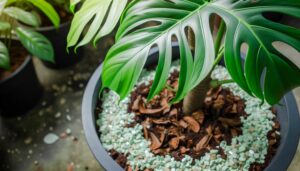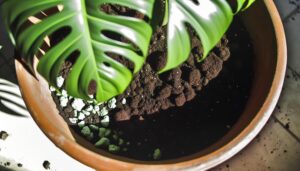How to Care for Monstera Adansonii? Expert Tips!
To care for Monstera Adansonii, place it in bright, indirect light, avoiding direct sunlight. Water when the top inch of soil is dry, using well-draining soil with peat moss, perlite, and orchid bark.
Maintain humidity between 60% and 80% and keep the temperature between 65°F and 80°F. Prune regularly to remove overgrown or damaged leaves using sterilized shears, and monitor for pests like spider mites and mealybugs.
Propagate using healthy cuttings with at least one node and an aerial root, ensuring consistent moisture and warmth. For detailed tips and advanced care strategies, there’s much more to discover.
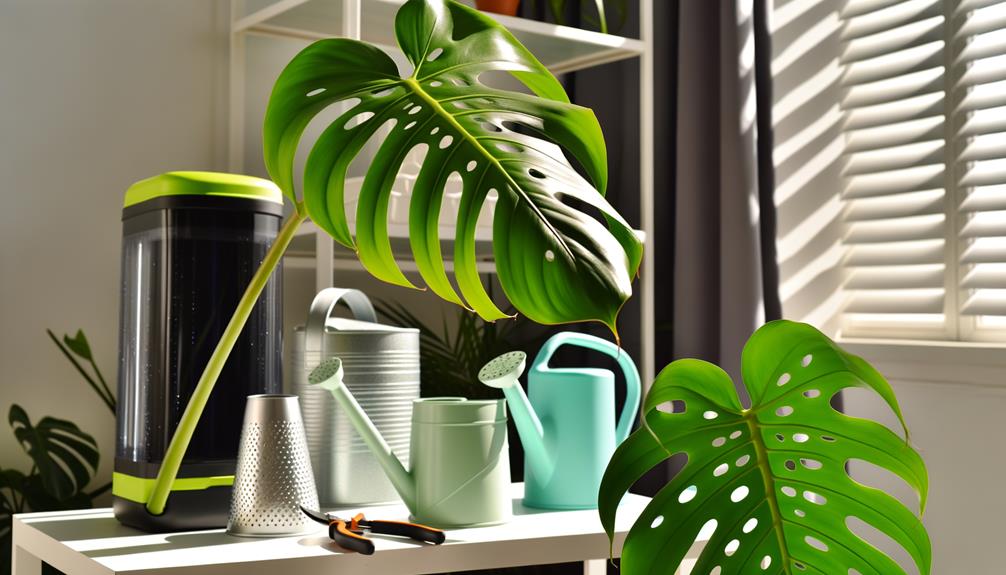
Key Takeaways
- Place in bright, indirect light and shield from direct sunlight to prevent leaf scorching.
- Water when the top inch of soil is dry, and use well-draining soil to avoid root rot.
- Maintain humidity levels between 60%-80% and keep temperatures between 65°F-80°F.
- Regularly prune overgrown stems and remove yellowing leaves with sterilized pruning shears.
- Monitor for pests like spider mites and mealybugs, and treat with insecticidal soap if necessary.
Ideal Lighting Conditions
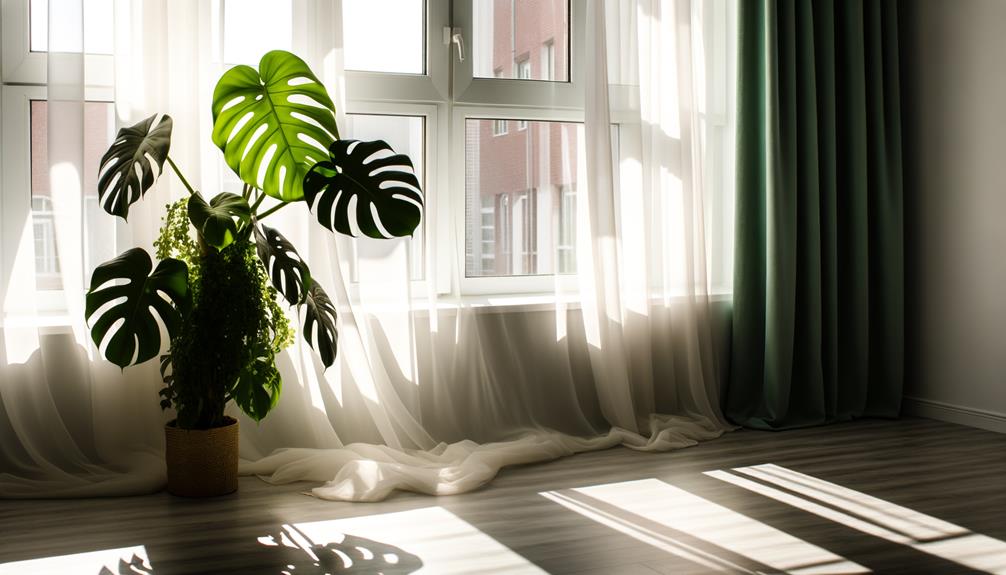
Monstera Adansonii thrives in bright, indirect light, making it crucial to place the plant near a north or east-facing window to ensure ideal growth. Direct sunlight can scorch its delicate leaves, so you should always shield it from harsh rays.
If natural light is insufficient, you can use a grow light with a spectrum that mimics daylight. Position the grow light approximately 12-18 inches above the plant and set it to run for 12-14 hours daily.
Monitor the plant for signs of inadequate lighting, such as stunted growth or pale leaves. Remember, consistent lighting promotes healthy photosynthesis, which is essential for the Monstera Adansonii’s overall health and development. Adjust the light source as needed to maintain optimal conditions.
Proper Watering Techniques
To achieve peak hydration, water the Monstera Adansonii when the top inch of soil feels dry to the touch. Use a moisture meter for precision, guaranteeing the reading is between 3-4.
When watering, saturate the soil thoroughly until excess water drains from the bottom. Avoid letting the plant sit in standing water as this can lead to root rot.
Utilize distilled or rainwater to prevent mineral buildup, which can harm the plant. Water less frequently during winter months due to reduced growth rates.
Maintain humidity levels around 60% for best hydration. By adhering to these guidelines, you’ll ensure your Monstera Adansonii receives the precise amount of water it needs for healthy growth.
Soil and Potting Mix
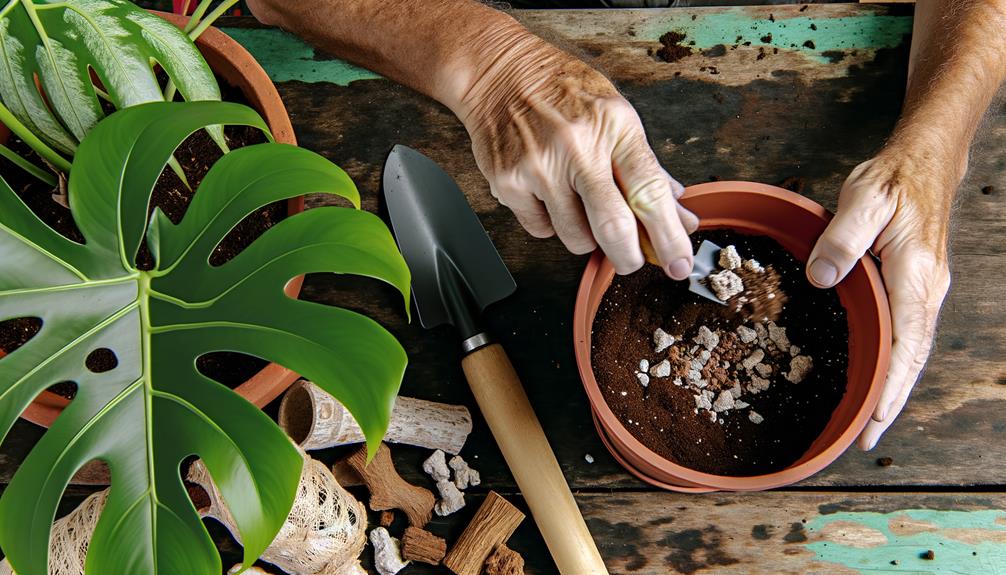
For best growth, you should guarantee your Monstera Adansonii has well-draining soil to prevent root rot.
An ideal potting mix includes components like peat moss, perlite, and orchid bark to provide aeration and retain moisture.
Regularly check the mix for compaction and refresh it annually to sustain soil health.
Well-Draining Soil Essentials
Why is well-draining soil important for Monstera Adansonii? Well-draining soil prevents root rot by allowing excess water to escape, ensuring roots receive both oxygen and moisture. You’ll want to avoid overly compacted soil since it retains too much water, depriving roots of oxygen, leading to fungal growth.
| Feature | Significance |
|---|---|
| Aeration | Supports healthy root growth |
| Water Retention | Prevents overwatering |
| Drainage | Decreases risk of root rot |
| Nutrient Delivery | Enhances nutrient absorption |
To achieve this, select a soil mix that balances moisture retention with proper drainage. Regularly check the soil’s condition and adjust watering practices accordingly. Ensuring well-draining soil is essential for your Monstera Adansonii’s longevity and health.
Ideal Potting Mix Components
A well-balanced potting blend for Monstera Adansonii should combine elements that offer aeration, drainage, and nutrient retention.
Start with one part peat moss to retain moisture without waterlogging.
Add one part perlite, which enhances aeration and prevents compaction.
Incorporate one part orchid bark; its chunky texture improves drainage and mimics the plant’s natural epiphytic environment.
For nutrient retention, mix in a small amount of compost or worm castings.
Maintain the pH level between 5.5 and 7 for vital nutrient uptake.
Avoid dense soils, as they can suffocate roots.
By blending these components, you create an environment that promotes healthy root growth and overall plant essentiality.
Don’t forget to re-pot every 1-2 years to refresh the mix.
Humidity Requirements
Maintaining Monstera Adansonii thriving necessitates keeping humidity levels between 60% and 80%, replicating its natural tropical environment. Use a hygrometer to monitor ambient humidity accurately.
Employ a humidifier to maintain prime levels; ultrasonic models are particularly effective. Alternatively, place the plant on a humidity tray filled with water and pebbles, ensuring the pot base doesn’t touch the water to prevent root rot.
Grouping plants can also create a microenvironment with higher humidity. Misting the leaves is another method, but make sure it’s done in the morning to allow evaporation, reducing the risk of fungal issues.
Avoid placing the plant near air vents or drafts, as these can significantly reduce humidity levels, hindering growth.
Temperature Range
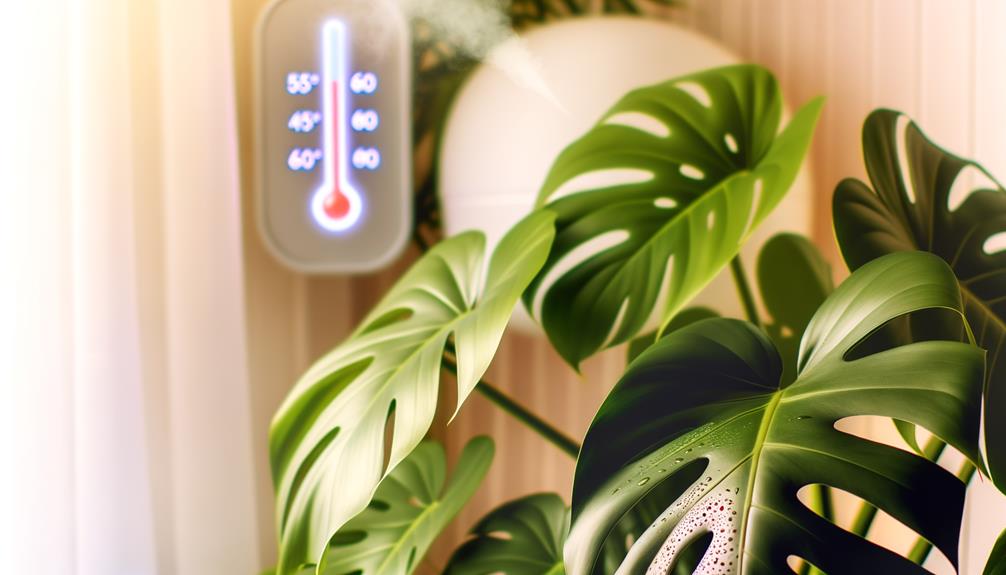
To achieve perfect growth, keep your Monstera Adansonii within a temperature range of 65°F to 80°F (18°C to 27°C). This tropical plant thrives in consistent, moderate warmth. Avoid sudden temperature changes and drafts, which can stress the plant.
Follow these guidelines to maintain prime conditions:
- Monitor Temperature: Use a reliable thermometer to verify the environment stays within the ideal range.
- Avoid Cold Drafts: Place your plant away from windows or doors that may let in chilly air.
- Heat Sources: Keep the plant away from direct heat sources like radiators, which can cause dehydration.
- Seasonal Adjustments: In winter, consider moving the plant to a warmer room or using a space heater to maintain consistent temperatures.
Proper temperature management helps ensure your Monstera Adansonii remains healthy and vibrant.
Fertilizing Schedule
To achieve peak growth for your Monstera Adansonii, use a balanced liquid fertilizer with an N-P-K ratio of 20-20-20.
Apply the fertilizer every two weeks during the active growing season, typically from spring to early autumn.
Reduce feeding to once a month during the plant’s dormant period in winter.
Optimal Fertilizer Types
Choosing the right fertilizer for your Monstera Adansonii involves understanding its nutrient needs and establishing a consistent fertilizing schedule tailored to its growth cycle. Use a balanced, water-soluble fertilizer with an N-P-K ratio of 20-20-20 to promote ideal growth.
Administer the fertilizer biweekly during the active growth period. Here’s how you can do it:
- Dilution: Mix the fertilizer at half the recommended strength to prevent root burn.
- Application: Apply the solution directly to the soil, avoiding foliage to prevent leaf damage.
- Timing: Fertilize in the morning to allow nutrients to absorb throughout the day.
- Monitoring: Observe the plant for signs of over-fertilization, such as yellowing leaves, and adjust accordingly.
Seasonal Feeding Patterns
Understanding the seasonal feeding patterns of your Monstera Adansonii is crucial for maintaining its health and promoting robust growth throughout the year.
During the active growing season, typically spring and summer, you should fertilize your plant more often to support increased metabolic activities. Opt for a balanced, water-soluble fertilizer to provide essential macronutrients.
As growth slows in fall and winter, reduce feeding to avoid nutrient buildup and potential root damage. Monitor the plant’s response to environmental changes, adjusting the fertilizing schedule accordingly. Guarantee consistent soil moisture to facilitate nutrient absorption, and always apply fertilizer to damp soil to prevent root burn.
Dosage and Frequency
When determining the appropriate dosage and frequency for fertilizing your Monstera Adansonii, consider the plant’s size, growth stage, and the specific formulation of the fertilizer you’re using. Typically, a balanced, water-soluble fertilizer with a 20-20-20 N-P-K ratio works well.
Follow these steps:
- Dilution: Mix the fertilizer at half the recommended strength to avoid nutrient burn.
- Frequency: Fertilize every 4-6 weeks during the growing season (spring and summer).
- Application: Apply the fertilizer directly to the soil, avoiding leaves to prevent damage.
- Observation: Monitor the plant for signs of over-fertilization, such as yellowing leaves, and adjust accordingly.
Pruning and Training
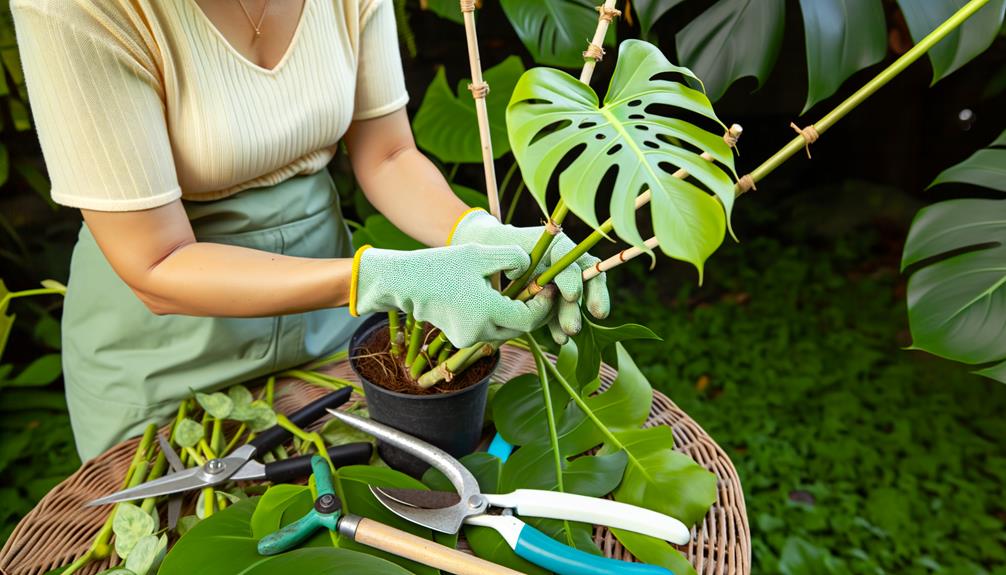
To maintain the health and shape of your Monstera Adansonii, regularly prune by cutting back overgrown stems and remove any damaged or yellowing leaves. Use sterilized pruning shears to make clean cuts just above a leaf node or junction. This encourages new growth and prevents disease.
For training, provide a support structure like a moss pole or trellis. Secure the stems to the support with plant ties, ensuring they’re not too tight to avoid constriction. Regularly check and adjust ties as the plant grows. This mimics natural climbing behavior and promotes a more aesthetically pleasing form.
Common Pests and Diseases
Inspecting your Monstera Adansonii regularly helps you identify common pests and diseases early, ensuring prompt treatment and minimizing damage.
- First, look for spider mites, which create fine webbing on leaves and cause stippling.
- Second, check for scale insects that appear as small, brown bumps and excrete honeydew.
- Third, be vigilant for root rot, often caused by overwatering, signaled by yellowing leaves and a musty odor.
- Fourth, monitor for mealybugs, which leave white, cotton-like residues and can be controlled with insecticidal soap.
Here’s a checklist for your convenience:
- Spider Mites: Fine webbing and stippling on leaves.
- Scale Insects: Small brown bumps, honeydew secretion.
- Root Rot: Yellowing leaves, musty odor, overwatering.
- Mealybugs: White, cotton-like residues, treat with insecticidal soap.
Propagation Methods

Successfully propagating your Monstera Adansonii involves using healthy stem cuttings, making sure each has at least one node and an aerial root.
First, use sterilized pruning shears to make precise cuts. Place the cuttings in water, immersing the node but not the leaves. Change the water every few days to prevent bacterial growth.
Within two to four weeks, roots should develop. Once roots are two inches long, transfer the cuttings to a pot with moist, well-draining soil. Maintain high humidity and indirect light to promote growth.
Alternatively, you can plant cuttings directly in soil but ensure consistent moisture and warmth for successful rooting. Both methods require patience and careful monitoring for best results.
Conclusion
Caring for your Monstera adansonii might seem complex, but with the right knowledge, you’ll master it. Don’t worry if you lack a green thumb; these plants are forgiving.
Make sure they receive bright, indirect light, maintain consistent humidity, and water when the top inch of soil is dry. Use a well-draining potting mix and keep them in a warm environment.
Follow a regular fertilizing schedule and prune to encourage growth. Soon, you’ll have a thriving, stunning plant.




